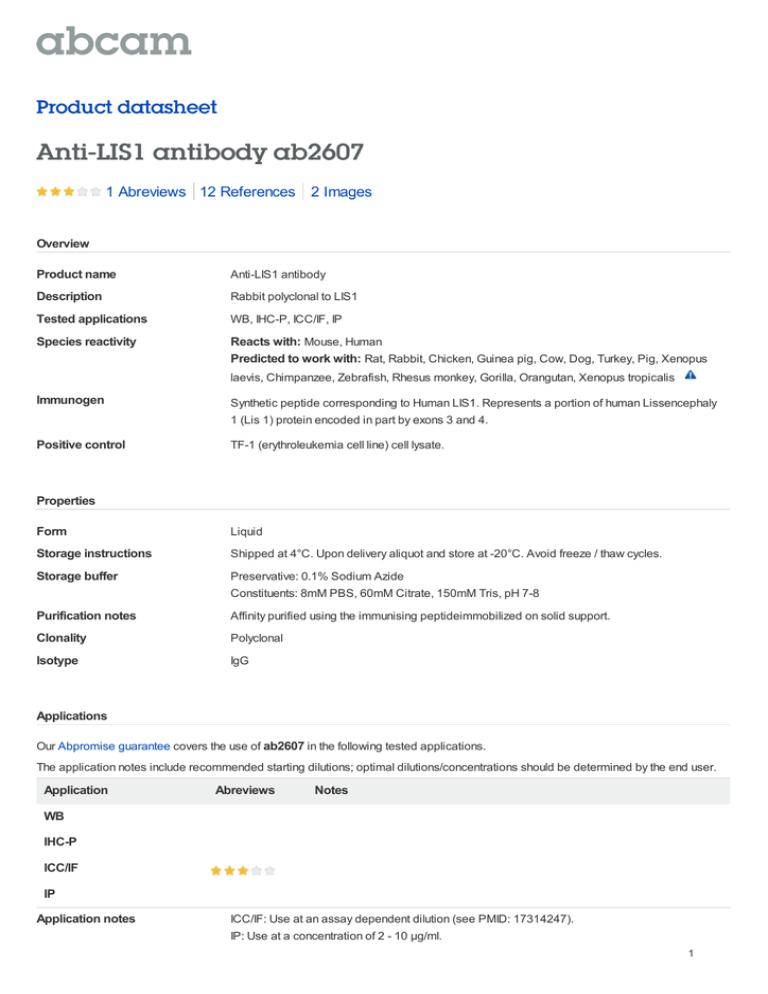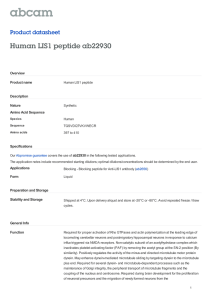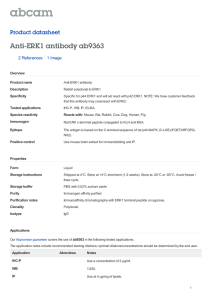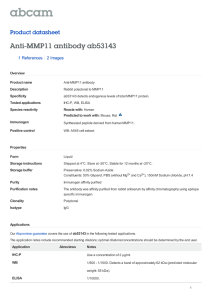Anti-LIS1 antibody ab2607 Product datasheet 1 Abreviews 2 Images
advertisement

Product datasheet Anti-LIS1 antibody ab2607 1 Abreviews 12 References 2 Images Overview Product name Anti-LIS1 antibody Description Rabbit polyclonal to LIS1 Tested applications WB, IHC-P, ICC/IF, IP Species reactivity Reacts with: Mouse, Human Predicted to work with: Rat, Rabbit, Chicken, Guinea pig, Cow, Dog, Turkey, Pig, Xenopus laevis, Chimpanzee, Zebrafish, Rhesus monkey, Gorilla, Orangutan, Xenopus tropicalis Immunogen Synthetic peptide corresponding to Human LIS1. Represents a portion of human Lissencephaly 1 (Lis 1) protein encoded in part by exons 3 and 4. Positive control TF-1 (erythroleukemia cell line) cell lysate. Properties Form Liquid Storage instructions Shipped at 4°C. Upon delivery aliquot and store at -20°C. Avoid freeze / thaw cycles. Storage buffer Preservative: 0.1% Sodium Azide Constituents: 8mM PBS, 60mM Citrate, 150mM Tris, pH 7-8 Purification notes Affinity purified using the immunising peptideimmobilized on solid support. Clonality Polyclonal Isotype IgG Applications Our Abpromise guarantee covers the use of ab2607 in the following tested applications. The application notes include recommended starting dilutions; optimal dilutions/concentrations should be determined by the end user. Application Abreviews Notes WB IHC-P ICC/IF IP Application notes ICC/IF: Use at an assay dependent dilution (see PMID: 17314247). IP: Use at a concentration of 2 - 10 µg/ml. 1 WB: 1/300 - 1/3000. Suggested working dilution of 1/1000 (see PMID: 17314247). IHC-P: Use at a concentration of 2 µg/ml. Perform heat mediated antigen retrieval before commencing with IHC staining protocol. Not yet tested in other applications. Optimal dilutions/concentrations should be determined by the end user. Target Function Required for proper activation of Rho GTPases and actin polymerization at the leading edge of locomoting cerebellar neurons and postmigratory hippocampal neurons in response to calcium influx triggered via NMDA receptors. Non-catalytic subunit of an acetylhydrolase complex which inactivates platelet-activating factor (PAF) by removing the acetyl group at the SN-2 position (By similarity). Positively regulates the activity of the minus-end directed microtubule motor protein dynein. May enhance dynein-mediated microtubule sliding by targeting dynein to the microtubule plus end. Required for several dynein- and microtubule-dependent processes such as the maintenance of Golgi integrity, the peripheral transport of microtubule fragments and the coupling of the nucleus and centrosome. Required during brain development for the proliferation of neuronal precursors and the migration of newly formed neurons from the ventricular/subventricular zone toward the cortical plate. Neuronal migration involves a process called nucleokinesis, whereby migrating cells extend an anterior process into which the nucleus subsequently translocates. During nucleokinesis dynein at the nuclear surface may translocate the nucleus towards the centrosome by exerting force on centrosomal microtubules. May also play a role in other forms of cell locomotion including the migration of fibroblasts during wound healing. Tissue specificity Fairly ubiquitous expression in both the frontal and occipital areas of the brain. Involvement in disease Defects in PAFAH1B1 are the cause of lissencephaly type 1 (LIS1) [MIM:607432]; also known as classic lissencephaly. LIS1 is characterized by agyria or pachgyria and disorganization of the clear neuronal lamination of normal six-layered cortex. The cortex is abnormally thick and poorly organized with 4 primitive layers. LIS1 is associated with enlarged and dysmorphic ventricles and often hypoplasia of the corpus callosum. Defects in PAFAH1B1 are the cause of subcortical band heterotopia (SBH) [MIM:607432]. SBH is a mild brain malformation of the lissencephaly spectrum. It is characterized by bilateral and symmetric ribbons of gray matter found in the central white matter between the cortex and the ventricular surface. Defects in PAFAH1B1 are a cause of Miller-Dieker lissencephaly syndrome (MDLS) [MIM:247200]. MDLS is a contiguous gene deletion syndrome of chromosome 17p13.3, characterized by classical lissencephaly and distinct facial features. Additional congenital malformations can be part of the condition. Sequence similarities Belongs to the WD repeat LIS1/nudF family. Contains 1 LisH domain. Contains 7 WD repeats. Domain Dimerization mediated by the LisH domain may be required to activate dynein. Cellular localization Cytoplasm > cytoskeleton. Cytoplasm > cytoskeleton > centrosome. Cytoplasm > cytoskeleton > spindle. Nucleus membrane. Redistributes to axons during neuronal development. Also localizes to the microtubules of the manchette in elongating spermatids and to the meiotic spindle in spermatocytes (By similarity). Localizes to the plus end of microtubules and to the centrosome. May localize to the nuclear membrane. Anti-LIS1 antibody images 2 Western blot - LIS1 antibody (ab2607) ab2607 (2µg/ml) staining Lis1 in human testis using an automated system (DAKO Autostainer Plus). Using this protocol there is strong staining of cytoplasmic compartment of the mature spermatocyte cells. Sections were rehydrated and antigen retrieved with the Dako 3 in 1 AR buffer EDTA pH 9.0 in a DAKO PT link. Slides were peroxidase blocked in 3% H2O2 in methanol Immunohistochemistry (Formalin/PFA-fixed for 10 mins. They were then blocked with paraffin-embedded sections)-LIS1 Dako Protein block for 10 minutes (containing antibody(ab2607) casein 0.25% in PBS) then incubated with primary antibody for 20 min and detected with Dako envision flex amplification kit for 30 minutes. Colorimetric detection was completed with Diaminobenzidine for 5 minutes. Slides were counterstained with Haematoxylin and coverslipped under DePeX. Please note that, for manual staining, optimization of primary antibody concentration and incubation time is recommended. Signal amplification may be required. Please note: All products are "FOR RESEARCH USE ONLY AND ARE NOT INTENDED FOR DIAGNOSTIC OR THERAPEUTIC USE" Our Abpromise to you: Quality guaranteed and expert technical support Replacement or refund for products not performing as stated on the datasheet Valid for 12 months from date of delivery Response to your inquiry within 24 hours We provide support in Chinese, English, French, German, Japanese and Spanish Extensive multi-media technical resources to help you We investigate all quality concerns to ensure our products perform to the highest standards 3 If the product does not perform as described on this datasheet, we will offer a refund or replacement. For full details of the Abpromise, please visit http://www.abcam.com/abpromise or contact our technical team. Terms and conditions Guarantee only valid for products bought direct from Abcam or one of our authorized distributors 4

![Anti-LIS1 antibody [EPR3335(2)] ab109630 Product datasheet 3 Images Overview](http://s2.studylib.net/store/data/012631586_1-9cc3b50d0adef26bb6d68b669178c8d9-300x300.png)





